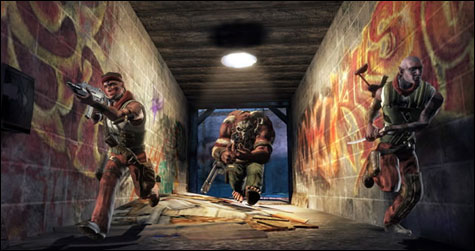
THINK BEFORE YOU ACT? You will if you want to succeed in this one. |
“I need a rez!” The elf staggered toward me, blood spurting from his neck. “I need a rez!”
Only problem: I didn’t have the resurrection spell. Which meant I couldn’t heal my elven teammate. Which meant that, seconds later, he was lying dead on the ground. I slunk away, ashamed, feeling like Corporal Upham in Saving Private Ryan when he stands on the staircase listening to Mellish getting shanked. Our side lost the match.
This is the world of Shadowrun, a first-person shooter that prizes teamwork over dead aim. It’s based on a much loved pen-and-paper role-playing game from the 1980s that was later adapted to the Super Nintendo and Sega Genesis. Shadowrun posits a near future in which humans and “metahumans” battle for control of magic and technology — and, thus, the world. The switch from the property’s role-playing roots to a multiplayer action game was greeted with howls of protest from the fans, but the transition to the Xbox 360 and PC is smooth. It may look like another Halo retread, but Shadowrun adds a cerebral element this genre typically lacks.
The RPG origins are most evident in Shadowrun’s class system. Apart from humans — whose strengths lie in weapons and technology — there are playable metahumans, each with different attributes. Elves are quick and adept at magic; the slower dwarves have a knack for anti-magic; as it sustains damage, the skin of the hulking trolls hardens to prevent further wounds. The underlying principle is the same, however: use your powers too often and they’ll temporarily run out.
In theory, the vast combinations of magic and technology lead to never-ending chess games between players. At the beginning of each round, you have the option of purchasing weapons and abilities. You can map three abilities to the shoulder buttons, but it’s difficult to juggle more than that. For example, a spell called Smoke makes the user invincible for a short time. The only way to damage a Smoke user is to cast a counterspell called Gust, but if you don’t have Gust quick-mapped, you’re out of luck, unless you can access a menu before your opponent moves out of the way. Don’t bet on that.
What’s more interesting about the spells and the tech is that everything has not only a weakness but also a downside. Take the resurrection spell. When a teammate dies, you can bring him back to life. But then if you die, he will begin to “bleed out,” and only a resurrection spell from another teammate will save him. (That’s the situation that led to the above-mentioned Corporal Upham moment.) It may not always be the right play to resurrect a teammate. Shadowrun is unique in the decisions it demands in the heat of battle.
At this early stage in the game’s life cycle, however, most of the interesting possibilities are left unexplored. In public matches, I noticed people’s inordinate tendency to play as the elf class and stick to the same weapons and spells. No doubt this will change in time, but right now people are not using much imagination. Another problem is the lack of varied game types: every match centers on trying to smuggle a magical artifact out of the level. Still, I’m convinced that a great game is lurking in there somewhere. It may emerge as the Shadowrun community matures.